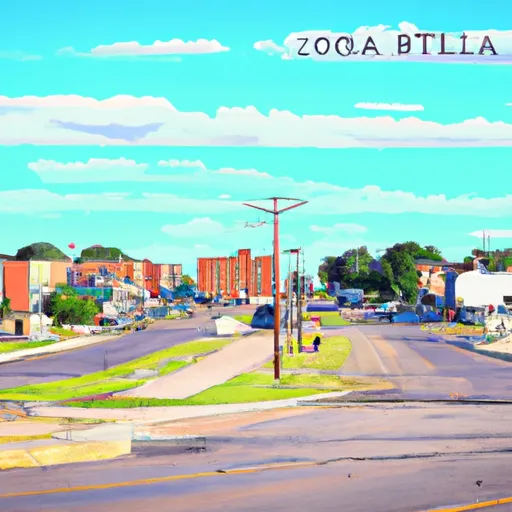-
 Snoflo Premium
Snoflo Premium
Get unlimited access to all our content
With no Ad interruptions! - Start Your Free Trial Login with existing account
Isabella
Eden Index
Climate
8.3
•
Recreation
0.3
•
Community
•
Safeguard
3.4/10

Isabella, Oklahoma is a small town located in the southern part of the state. It experiences a humid subtropical climate, characterized by hot summers and mild winters. Summers are usually hot and humid, with temperatures often reaching the 90s°F (32°C) or higher. Winters are generally mild with temperatures averaging in the 40s°F (4-9°C). The area receives moderate rainfall throughout the year, with the wettest months occurring in spring and early summer.
Hydrologically, Isabella is situated near the Washita River, which is a major waterway in the region. The river serves as a vital source of water for the town and supports various aquatic species. Additionally, there are several small lakes and ponds scattered throughout the area, providing opportunities for fishing and boating.
Outdoor recreation enthusiasts can enjoy a range of activities in the vicinity of Isabella. The Washita National Wildlife Refuge is located nearby, offering opportunities for bird watching, hiking, and wildlife photography. Fishing and hunting are popular activities in the region as well, with various game species available, including deer and turkey. Additionally, the local landscape is ideal for camping and nature exploration, with several parks and trails available for visitors to enjoy the natural beauty of Isabella, Oklahoma.
What is the Eden Index?
The Snoflo Eden Index serves as a comprehensive rating system for regions, evaluating their desirability through a holistic assessment of climate health, outdoor recreation opportunities, and natural disaster risk, acknowledging the profound impact of these factors on livability and well-being.
Climate Health Indicator (CHI): 8.3
Isabella receives approximately
761mm of rain per year,
with humidity levels near 81%
and air temperatures averaging around
16°C.
Isabella has a plant hardyness factor of
7, meaning
plants and agriculture in this region tend to thrive during the non-winter months.
By considering the ideal temperature range, reliable water supplies, clean air, and stable seasonal rain or snowpacks, the Climate Health Indicator (CHI) underscores the significance of a healthy climate as the foundation for quality living.
A healthy climate is paramount for ensuring a high quality of life and livability in a region, fostering both physical well-being and environmental harmony. This can be characterized by ideal temperatures, reliable access to water supplies, clean air, and consistent seasonal rain or snowpacks.
Weather Forecast
Streamflow Conditions
Lower Cimarron
Area Rivers
Lower Cimarron
Snowpack Depths
Lower Cimarron
Reservoir Storage Capacity
Lower Cimarron
Groundwater Levels
Recreational Opportunity Index (ROI): 0.3
The Recreational Opportunity Index (ROI) recognizes the value of outdoor recreational options, such as parks, hiking trails, camping sites, and fishing spots, while acknowledging that climate plays a pivotal role in ensuring the comfort and consistency of these experiences.
Access to outdoor recreational opportunities, encompassing activities such as parks, hiking, camping, and fishing, is crucial for overall well-being, and the climate plays a pivotal role in enabling and enhancing these experiences, ensuring that individuals can engage in nature-based activities comfortably and consistently.
Camping Areas
| Campground | Campsites | Reservations | Toilets | Showers | Elevation |
|---|---|---|---|---|---|
| Fort Cobb - Area 3 | None | 1,378 ft | |||
| Fort Cobb - Area 5 | None | 1,380 ft | |||
| Edgewater Park - Lawton | None | 1,246 ft | |||
| Robinsons Landing - Lake Lawtonka | None | 1,355 ft | |||
| Fort Cobb - Area 1 | None | 1,359 ft | |||
| East Side - Lake Lawtonka | 35 | 1,365 ft | |||
| Randlett Park | None | 1,192 ft | |||
| Fort Cobb - Area 2 | None | 1,360 ft | |||
| Lake Chickasha | 50 | 1,207 ft | |||
| Collier Landing City | None | 1,241 ft |
Nearby Ski Areas
Catastrophe Safeguard Index (CSI):
The Catastrophe Safeguard Index (CSI) recognizes that natural disaster risk, encompassing floods, fires, hurricanes, and tornadoes, can drastically affect safety and the overall appeal of an area.
The level of natural disaster risk in a region significantly affects safety and the overall livability, with climate change amplifying these risks by potentially increasing the frequency and intensity of events like floods, fires, hurricanes, and tornadoes, thereby posing substantial challenges to community resilience and well-being.
Community Resilience Indicator (CRI):
The Community Resilience Indicator (CRI) recognizes that education, healthcare, and socioeconomics are crucial to the well-being of a region. The CRI acknowledges the profound impact of these elements on residents' overall quality of life. By evaluating educational resources, healthcare accessibility, and economic inclusivity, the index captures the essential aspects that contribute to a thriving community, fostering resident satisfaction, equity, and social cohesion.

